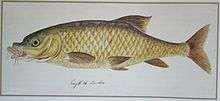Moggel
Moggel (Labeo umbratus) is a freshwater African fish in genus Labeo. It occurs within the drainage basin of the Orange River. The species has been recorded in the [Vaal], Olifants River in Mpumalanga and Limpopo, introduced there by anglers.
| Moggel | |
|---|---|
 | |
| Painted by Johannes Schumacher (1779) | |
| Scientific classification | |
| Kingdom: | Animalia |
| Phylum: | Chordata |
| Class: | Actinopterygii |
| Order: | Cypriniformes |
| Family: | Cyprinidae |
| Subfamily: | Labeoninae |
| Genus: | Labeo |
| Species: | L. umbratus |
| Binomial name | |
| Labeo umbratus (A. Smith, 1841) | |
| Synonyms | |
This species is similar to L. capensis in colour and in its pronounced anterior barbels. It can withstand temperatures below 10 °C and is mainly found in stagnant water, muddy dams and in large impoundments. Juveniles of the species prey on invertebrates while adults subsist on detritus and mud. It is an important food source and is considered a useful species in wastewater aquaculture when combined with other aquatic organisms.[2]
Size
Length: 500mm. Weight: 2.9KG
Distribution
Africa: within the drainage basin of the Orange river and in southern watersheds of the Cape region. There are records of Labeo umbratus from the Olifant's river (Limpopo system) where it has been introduced by anglers. Has also been translocated in the Olifants-Limpopo system.
Behavior
Found mainly in standing waters, shallow dams and muddy shallow areas such as in large impoundments. Juveniles feed on small invertebrates while adults feed on detritus and mud soft sediments.
Breeding
Breeds after rains in summer, migrating upstream to suitable spawning sites, usually over flooded grassy banks of rivers with shallow rocky sections. Female lays about 250 000 small sticky eggs which attach to grass and rocks, they hatch after 40 hours thereafter the newly hatched larvae repeatedly swim to the surface and get carried away by the current to deeper water.[3]
Uses
Valued as an important, nutritious food source and is recommended for use in wastewater aquaculture in combination with other aquatic organisms.[2]
Occasionally caught by anglers using bait or flies whilst targeting other species, is known for its strong fighting ability. It is often regarded as an 'easter egg' fish when caught as they are nearly impossible to target specifically, catches are usually by chance. Important in commercial and subsistence fisheries and also used in aquaculture and physiological research.[3]
References
- Swartz, E.; Impson, D. (2007). "Labeo umbratus". The IUCN Red List of Threatened Species: 2007: e.T63288A12635757. doi:10.2305/IUCN.UK.2007.RLTS.T63288A12635757.en.
- FishBase
- Skelton, Paul H. (1993). A Complete Guide to the Freshwater Fishes of Southern Africa. Southern book publishers. pp. 177–178. ISBN 1 86812 493 2.
